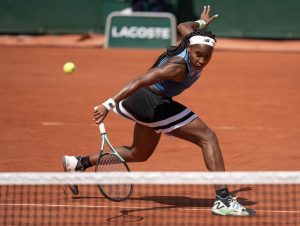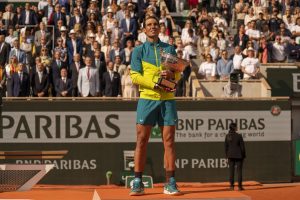Most children learning tennis are taught from a pretty early age to step in on the opponents second serve. Apply pressure on the server by attacking it accordingly. Almost all professional tennis players seem to have been taught in a similar way. Dominic Thiem though, appears to have skipped that particular class.
There is nothing unusual about where he stands to return the first serve. It is, as with most players, a little bit behind the baseline. Where he differs is on the second serve. Bizarrely, the Austrian commonly chooses to take two or three steps away from the baseline instead of towards it.
Embed from Getty Images
It is not uncommon knowledge that Dominic Thiem stands a hefty distance behind the baseline. The lengthiness of his swing make it almost a necessity and it is exactly this technique that makes him such a potent force on clay. The problem is that, while this may be effective on clay, it simply does not work as well on hard or grass courts.
The normal television camera angle – from behind the baseline – makes the position of return less noticeable. Watching a match from the side however, (my location for Dominic Thiem against Grigor Dimitrov at the Nitto ATP Finals), makes it far more obvious. It makes its effectiveness, or rather lack of, particularly clear on a hard court.
Embed from Getty Images
Dominic Thiem struggles on return in defeat against Grigor Dimitrov
It appeared, at least to the naked eye, that choosing to return from that far back was causing more problems than solutions. The most obvious was that there was a large number of framed returns off his racket. As simple as it may sound, by standing so far back Thiem had to expend more energy to get the ball to travel further and with more depth. This consequently led to a number of silly framed errors in the first set against Dimitrov.
The other issue was that it allowed the server time to recover. One of the main reasons to attack the second serve is to catch the opponent off balance as they recover from their service motion. By standing further back, this allowed Dimitrov ample time to recover. Given the poise and agility of Dimitrov, this was a baffling tactical decision by the Austrian.
That is not to say that returning from deep behind the baseline does not work. Minimal research is needed to find footage of Rafael Nadal obliterating opponents serves from way behind the baseline. The difference is, Nadal still steps forward on the second serve and attacks the ball. This way he still looks to create an advantage from the second serve, something Thiem does not.
Embed from Getty Images
Can Dominic Thiem’s return be fixed?
The next question is whether this is a fixable problem or whether it will remain a career-long limitation. For Dominic Thiem it is not simply a case of just stepping forward more, even if that does seem the obvious fix. His issues lie more in the technical construction of his groundstokes. His swing is large and lengthy, hence the need to stand so far back. The motion means that a short, punchy return that players such as Dimitrov, Roger Federer and Andy Murray can do are virtually impossible. In order to fix his return position, he first needs to shorten his stroke on the return.
He may possess an impressive style and boast ATP titles on every surface but his game on a hard court is limited by the return. On clay, he was statistically the 8th best returner during the 2017 season. This figure is drastically different on hard court, where Thiem was 33rd for the year. While his grass court return ranking is as low as 72nd, this should be taken with a pinch of salt given the lower quantity of data.
Embed from Getty Images
Even so, the huge difference between these figures is not good enough for a player with Grand Slam and World No.1 aspirations. In order to be one of the very best players in the world you have to learn to transition your game to all surfaces and adapt your tactics accordingly. As it stands, this is an area of his game that Thiem needs to improve.
Few doubt that Dominic Thiem will, one day, win a French Open title. He is too talented on the surface not to. The chances of him becoming an all-court threat are much slimmer though, especially when you consider the style of other youngsters like Alexander Zverev. On the whole, his return is by no means weak. It is enough of a limitation though, to stop him from being the World No.1. For now at least.
LastWordOnTennis would like to thank O2 Sports, the sponsor of the O2 arena, for giving us the tremendous opportunity to attend several sessions of the ATP Finals.
Main Photo:
Embed from Getty Images






